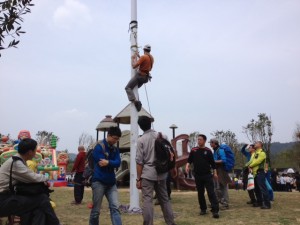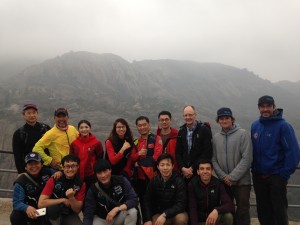April 3, 2014
IMG has worked with the Chinese Mountaineering Association (CMA) since the 1980’s so it was no surprise that they got in touch recently to see if we could send over a couple of our IMG guides for a mountaineering safety seminar. Every year CMA hosts this meeting, and for 2015 it was in Wenzhou, which is south of Shanghai. The CMA calls on many of the other Chinese provinces, nearby countries (Korea, Taiwan, etc.) and a few more distant countries (USA, Norway, Switzerland, etc.) to send representatives to the program. The purpose of these annual seminars is to share knowledge and to help create a standard that can be recognized worldwide in the mountaineering community. This year, the topic of discussion was mountain rescue, and representing IMG and the USA were senior guides Aaron Mainer and Mike Haft. Mike’s trip report is below.
– Eric Simonson
- Improvisation skills on display.
- A break-out session group photo.
The night before the seminar began, Aaron and I were asked to join the hosts of this seminar for a wonderful dinner. This dinner was held for the guest speakers of the seminar. The spread was impressive to say the least. There must have been 20 dishes constantly being passed around the table, including duck tongue (famous in Wenzhou), turtle soup, shark fin soup, and the fancy seafood dishes common to the Chinese culture. I came to three conclusions that evening. First, in China, there is no shortage of food at a formal dinner. Second, there is no shortage of “toasting” to show appreciation in China, and lastly, there is no shortage of hospitality in China. The night was a whirlwind of culture and conversation. We shared many tales of mountain adventures, laughed at the mutual friends we were unaware we had, and went to sleep satisfied from the events of the day.
The first day of the seminar was dedicated to the topic, “Accidents in Mountaineering.† I was literally the first speaker of the seminar. I talked about the American Alpine Club (AAC) and their publication  Accidents in North American Mountaineering, and how because of 60+ years of reported accidents and the case studies that accompany them, we are able to identify and learn from their common problems. Following my powerpoint, the other guest speakers presented on the same topic. Of the Europeans, there was Dan, a guide and the Vice President of the International Commission for Alpine Rescue (ICAR) from Norway, and Pascal who is a guide and professional mountain rescuer from Switzerland. It was fascinating to compare the statistics of the USA to Europe. What I gathered from listening to all of the presentations was that accidents happen, and will continue to happen. What will continue to change and evolve is how we deal with these accidents.
The second day of the seminar was originally going to focus on the structure of organized rescue in the various countries. However, due to bad weather, we adjusted some things and decided to present a live demo. The scenario Aaron and I presented was “how to rescue a lead climber as the belayerâ€.  Aaron and I demonstrated these skills three times to groups of 60. We didn’t quite have the best set-up for this demo but if there is anything a guide is good at, it is adaptive thinking and problem solving. Using our resources we decided that a 100ft tall light pole in the middle of a field would be our rescue scene. This alone was a spectacle in itself. The day was a success.
Finally, on the third and last day of the seminar, each speaker presented their country’s or provinces’ newest and latest rescue gear and techniques. Aaron took this opportunity to focus on companion rescue involving glaciated terrain. His talk focused on the primary differences and similarities of “improvised” rescue vs. “organized” rescue, the gear that is involved, and how to use it.
There were close to 200 people from all around the world. We all had one common purpose, sharing information so we can learn from our mistakes and work towards a worldwide standard in mountain rescue techniques. It was a fun trip!
Mike Haft


